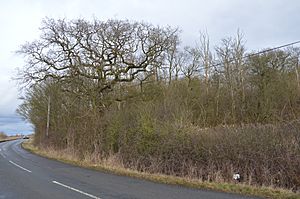Weaveley and Sand Woods facts for kids
| Site of Special Scientific Interest | |
 |
|
| Area of Search | Cambridgeshire |
|---|---|
| Interest | Biological |
| Area | 62.0 hectares |
| Notification | 1983 |
| Location map | Magic Map |
Weaveley and Sand Woods is a special natural area in Cambridgeshire, England. It covers about 62 hectares, which is like 150 football fields! This site is officially known as a Site of Special Scientific Interest (SSSI). This means it's a protected place because of its unique plants, animals, or geology.
Contents
Weaveley and Sand Woods: A Special Place
Weaveley and Sand Woods became a protected SSSI in 1983. This protection helps to keep its amazing natural features safe for the future. It's a really important spot for nature in the United Kingdom.
What Makes This Place Special?
One of the coolest things about Weaveley and Sand Woods is its varied ground. It has different types of soil and rock, which is unusual for one area.
- Some parts have "Lower Greensand," which is a type of sandy soil that lets water drain away easily.
- Other areas have "boulder clay," which is a heavy, sticky soil that holds water.
- There are also "Jurassic clays," which are even older types of clay from the Jurassic period.
This mix of soils creates different environments. Because of this, many different kinds of plants can grow here.
Ancient Woodland History
These woods are very old, meaning they have been woodlands for a very long time. Ancient woodlands are super important because they have stable environments. This allows rare plants and animals to thrive there. They are like natural time capsules!
Trees and Plants You Might Find
The woods are home to many types of trees. You'll find strong pedunculate oak trees here. There are also European ash and field maple trees. Some of these trees are "coppiced," which means they are cut back regularly. This old method helps the trees grow new shoots and keeps the woodland healthy.
The Shrub Layer
Below the tall trees, there's a "shrub layer." This is made up of smaller plants and bushes. Common hazel is very common here. It forms a thick layer that provides shelter and food for many animals.
Rare Flowers to Spot
Weaveley and Sand Woods is also famous for its uncommon flowers. If you were able to visit, you might spot:
- Herb-paris: A unique plant with four leaves and a single green flower.
- Butterfly orchid: A beautiful white orchid that looks a bit like a butterfly.
- Pignut: A small plant with a tasty, edible root that looks like a tiny nut.
These flowers are special because they don't grow just anywhere. They need the specific conditions found in ancient woodlands like Weaveley and Sand Woods.
Visiting the Woods
It's important to know that Weaveley and Sand Woods is on private land. This means there is no public access for visitors. Its protected status helps keep it safe and undisturbed for the wildlife that lives there.

